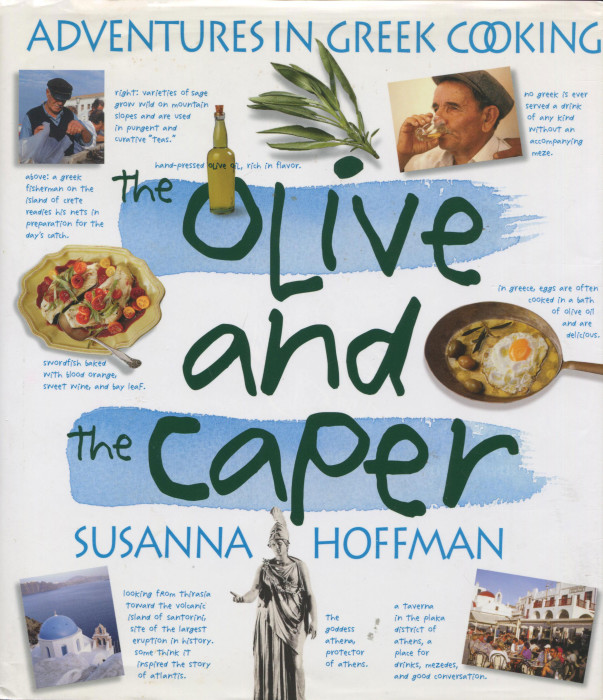The impression grows and builds: there is so much stuff here. Two hundred and fifty recipes, it is true, but the book grows to almost six hundred pages with all the side notes and head notes, journeys — some pages long — on history and wine and cheese. You begin to think that multiple people wrote this book: a chef, an archaeologist, an historian, an anthropologist.
And you would be right. All those people did compose this book, all rolled into the form of Susanna Hoffman. She happens to be Ph.D. sociologist who specializes in disasters. Social and not kitchen disasters. She’s a polymath — someone with exceptional skills in multiple and often very disparate areas of life. There is her very accomplishes academic side. Then there is the side that has lived and worked in Greece for decades, fashioning a database of information, a portfolio of authenic recipes, and a love for sunny island and rocky hillsides.
Published in 2004, I don’t think this book ever got the attention or praise it deserves. It really is a tour de force examination of Greece, the country, starting from the ground and the grain up. As you go from one recipe to another, only to be interrupted with a digression on the Byzantine Empire, you quickly find the interruptions are merely intermissions. Intermissions or intermezzos that, quite certainly, are charming and helpful.
I could take you on a chapter by chapter tour of The Olive and The Caper but that would be as long as a tour of ancient Greece itself, staring in Athens and bounding about to all those other cities, like Sparta, who could never quite get along. The Greek impulse for independence is fierce but local. Which is why, in about 340 BC, Alexander the Great rather easily conquered the whole place. There was no more Greek nation until over 2000 years later, 1832 AD.
Macedonians, Romans, Byzantines, and Ottomans ruled the land. But the Greeks ruled their cuisine.
If you think you know Greek food, because you have had spinach pie and baklava, then here are some of the best surprises that The Olive and The Caper has in store for you.
We all love our condiments, but have you ever had Artyma, a cooked delight of grapes, mustard seeds, almonds, pepper corns and lemon juice?
If you are tired of simple fish dishes, then you can elect to try the Baked White Fish Fillets with Blood Orange, Sweet Wine, and Bay Leaf.
Beef stew is comfort food, to be sure, but Beef Kapama with its Sauce of Wine, Brandy, Coffee, Honey, Tomato Paste, Cinnamon, Clove, and Bay Leaves must surely take comfort food to Olympian heights.
Mountainous and poor, Greek cuisine is focused on making the most of everything available. So humble bread can be elevated into Bread Soup with Garlic, Cucumber, Capers and Mint. Or you might try the Carrot Salad with Fresh Fennel, Dried Figs, and Preserved Lemon.
For a feast, you could try Duck Marinated with Ouzo, Orange and Cinnamon with a Sauce of Carrot, Onion and Herbs. Nuts and mint are rarely absent in these dishes. How about Lamb Pie with Almonds, Raisins, Orange and Mint. On the side you can have Squash and Cardamom Pie. And for dessert Sesame Cake with Sesame Frosting.
These are not the Greek dishes of Manhattan delis. Though, I am told by friends, that if I just went across the East River to Queens, I could “get the real thing.” That’s an experiment for another day.
For now, Suz and I are planning to nestle in and try some of these intriguing assemblages of multiple ingredients. Those ingredients are basic, to be sure, but the recipes cannot be called simple. We have been looking at a stuffing for turkey, yes, turkey in this Greek cookbook. It’s Pork, Chestnut and Fig Stuffing and we are considering our Thanksgiving options.
This is a lovely book, full of information and full of food, too. Time to visit the store, buy yogurt and mint and almonds and figs and some lamb, too, then return home and fashion a meal from a classic cuisine.

